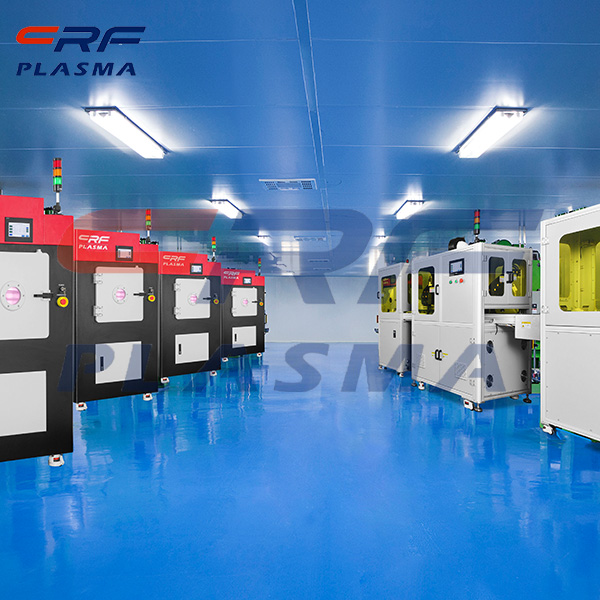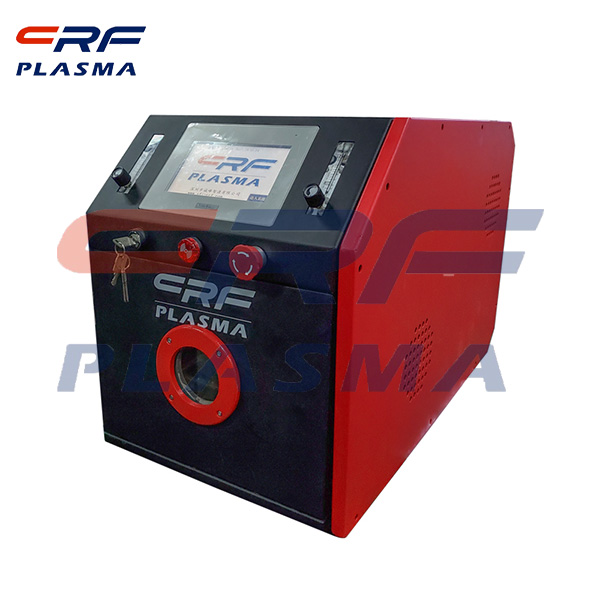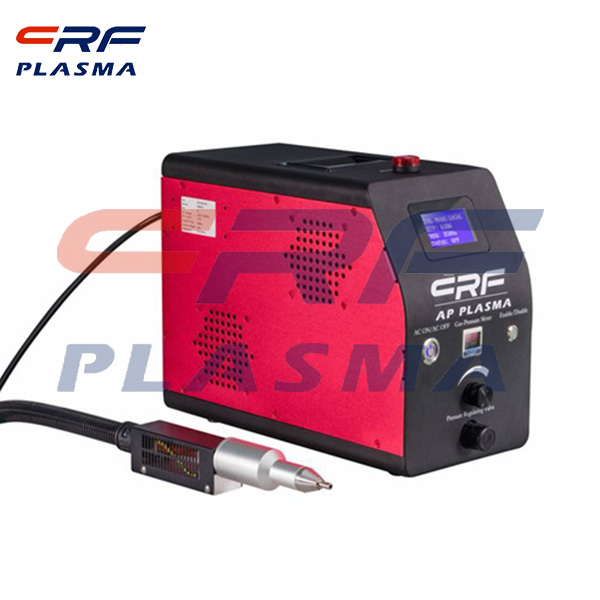
Welcome to Shenzhen Sing Fung Intelligent Manufacturing Co., Ltd.
E-mail:shaobo@sfi-crf.com
Etching of passivated layer dielectric aluminum pad by plasma Industrial Cleaning Machine
- Categories:Company Dynamics
- Author:plasma cleaning machine-surface treatment equipment-CRF plasma machine-Sing Fung Intelligent Manufacturing
- Origin:
- Time of issue:2020-11-17
- Views:
(Summary description)Etching of passivated layer dielectric material: Passivation layer is used to protect IC devices and metal connection structure, provide a certain stress buffer, not by subsequent cutting, cleaning and packaging process damage and corrosion of the protective layer. The dielectric materials used in the passivation layer are usually silicon oxide and silicon nitride materials, whose dimensions are micron scale and have no special requirements on the lateral wall contour curve. Passivation layer of dielectric material using single photoresist etching for film, etching to [F] for gas, usually is the combination of CF4 and CHF3 or CH2F2 accompanied by some dilute gas, plasma industrial cleaning machine by optimizing etching gas ratio, plasma source power and bias power and temperature adjustment side outline view, size and uniformity of plasma etching depth. Metal etching of aluminum pad: Aluminum metal etching usually USES photoresist as mask and is carried out in plasma metal etching reaction chamber. Because the product AlF3 is a non-volatile product with low vapor pressure, it can not be used to etch aluminum, usually it is etched with chlorine gas. Is isotropic etching aluminium, pure chlorine gas for the anisotropic etching process to get the contours of the curve and size, must be used in the process of etching polymer passivation wall for protection, in addition to zapped with plasma physics photoresist polymer, carbon capture to get some more prone to polymer gas as etching agent, such as CHF3, N, CH4, etc; At the same time, BCl3 gas is also widely used in aluminum etching by the plasma industrial cleaning machine. The main purpose is that BCl3 has excellent reactivity with [O] and [H] ions, and the [O] and [H] ions generated in the reaction chamber and the reaction process are taken away after the first reaction to reduce the possibility of aluminum etching termination and corrosion in the future. At the same time, BCl3 gas is decomposed into BClx in plasma, atomic group and positive ion. [BCl3]+ positive ion with a large molecular weight is an important ion source for the formation of plasma physical bombardment, which enhances the effect of physical bombardment. BClx atoms, on the other hand, can "recombine" with Cl atoms, as shown in Formula (3-8), which would normally occur without exposure to Cl atoms BClx + Cl - > BClx + 1 (3-8) This recombination reaction will consume chlorine atoms on the side wall surface under particle bombardment, reduce fluorine atoms adsorbed on the side wall, thus reducing side etching, improving the anisotropy of etching, and achieving a good control of the profile of the side wall contour. To join in the process of etching can quickly generate polymer provides wall protection gases such as CHF3, N2, or CH4, make relatively preferential adsorption on metal aluminum wall fluorine, nitrogen or hydrocarbons, to further reduce the chlorine atoms react with aluminum wall contact, protect wall, make chlorine gas to metal base aluminum ability of anisotropic etching is better. By studying the influence of these three kinds of gases on the side wall morphology of metal aluminum after etching, the results show that N2 protective gas produces too much side wall protection during etching, which is easy to form trapezoidal side wall morphology. The protection of CHF3 to the side wall is not perfect. CF4 gas provides uniform sidewall protection and maintains a nearly vertical sidewall Angle, providing sidewall protection. One difficulty in the etching of metal aluminum in the plasma industrial cleaning machine is the complexity of its multilayer metal composite film. TiN or other anti-reflection materials are often used in the composite film as a graphic exposure anti-reflection layer, and the adhesion barrier layer below, such as Ti or other materials, all increase the complexity of the etching process. To antireflective material layer on the surface of the etching, may use the chemical gas is Cl2 / SF6 / CF4 / CHF3 / BCl3 / Ar/O2 combination of these, and etching TiN antireflective film with Cl2 / BCl3 / N2 / CHF3 combination of them. In addition, since the oxidation of aluminum exposed to air occurs almost simultaneously, the production of aluminum oxide must be suppressed or controlled, otherwise the etching can be terminated. Typical steps for etching aluminum metal composite film are described in detail below: 1. Etch anti-reflective layer. 2. Remove the pre-etching of natural oxide layer on the surface (which may also be combined with step 1). 3. The main etching of metallic aluminum is usually detected by the reaction product detector to detect the etching termination of metallic aluminum. 4. Remove overetching of aluminum residues. This step may also be a continuation of the main etching step. 5. Etching of the bottom barrier layer (may also be combine
Etching of passivated layer dielectric aluminum pad by plasma Industrial Cleaning Machine
(Summary description)Etching of passivated layer dielectric material:
Passivation layer is used to protect IC devices and metal connection structure, provide a certain stress buffer, not by subsequent cutting, cleaning and packaging process damage and corrosion of the protective layer. The dielectric materials used in the passivation layer are usually silicon oxide and silicon nitride materials, whose dimensions are micron scale and have no special requirements on the lateral wall contour curve. Passivation layer of dielectric material using single photoresist etching for film, etching to [F] for gas, usually is the combination of CF4 and CHF3 or CH2F2 accompanied by some dilute gas, plasma industrial cleaning machine by optimizing etching gas ratio, plasma source power and bias power and temperature adjustment side outline view, size and uniformity of plasma etching depth.
Metal etching of aluminum pad:
Aluminum metal etching usually USES photoresist as mask and is carried out in plasma metal etching reaction chamber. Because the product AlF3 is a non-volatile product with low vapor pressure, it can not be used to etch aluminum, usually it is etched with chlorine gas. Is isotropic etching aluminium, pure chlorine gas for the anisotropic etching process to get the contours of the curve and size, must be used in the process of etching polymer passivation wall for protection, in addition to zapped with plasma physics photoresist polymer, carbon capture to get some more prone to polymer gas as etching agent, such as CHF3, N, CH4, etc; At the same time, BCl3 gas is also widely used in aluminum etching by the plasma industrial cleaning machine. The main purpose is that BCl3 has excellent reactivity with [O] and [H] ions, and the [O] and [H] ions generated in the reaction chamber and the reaction process are taken away after the first reaction to reduce the possibility of aluminum etching termination and corrosion in the future. At the same time, BCl3 gas is decomposed into BClx in plasma, atomic group and positive ion. [BCl3]+ positive ion with a large molecular weight is an important ion source for the formation of plasma physical bombardment, which enhances the effect of physical bombardment. BClx atoms, on the other hand, can "recombine" with Cl atoms, as shown in Formula (3-8), which would normally occur without exposure to Cl atoms
BClx + Cl - > BClx + 1 (3-8)
This recombination reaction will consume chlorine atoms on the side wall surface under particle bombardment, reduce fluorine atoms adsorbed on the side wall, thus reducing side etching, improving the anisotropy of etching, and achieving a good control of the profile of the side wall contour.
To join in the process of etching can quickly generate polymer provides wall protection gases such as CHF3, N2, or CH4, make relatively preferential adsorption on metal aluminum wall fluorine, nitrogen or hydrocarbons, to further reduce the chlorine atoms react with aluminum wall contact, protect wall, make chlorine gas to metal base aluminum ability of anisotropic etching is better. By studying the influence of these three kinds of gases on the side wall morphology of metal aluminum after etching, the results show that N2 protective gas produces too much side wall protection during etching, which is easy to form trapezoidal side wall morphology. The protection of CHF3 to the side wall is not perfect. CF4 gas provides uniform sidewall protection and maintains a nearly vertical sidewall Angle, providing sidewall protection.
One difficulty in the etching of metal aluminum in the plasma industrial cleaning machine is the complexity of its multilayer metal composite film. TiN or other anti-reflection materials are often used in the composite film as a graphic exposure anti-reflection layer, and the adhesion barrier layer below, such as Ti or other materials, all increase the complexity of the etching process. To antireflective material layer on the surface of the etching, may use the chemical gas is Cl2 / SF6 / CF4 / CHF3 / BCl3 / Ar/O2 combination of these, and etching TiN antireflective film with Cl2 / BCl3 / N2 / CHF3 combination of them. In addition, since the oxidation of aluminum exposed to air occurs almost simultaneously, the production of aluminum oxide must be suppressed or controlled, otherwise the etching can be terminated. Typical steps for etching aluminum metal composite film are described in detail below:
1. Etch anti-reflective layer.
2. Remove the pre-etching of natural oxide layer on the surface (which may also be combined with step 1).
3. The main etching of metallic aluminum is usually detected by the reaction product detector to detect the etching termination of metallic aluminum.
4. Remove overetching of aluminum residues. This step may also be a continuation of the main etching step.
5. Etching of the bottom barrier layer (may also be combine
- Categories:Company Dynamics
- Author:plasma cleaning machine-surface treatment equipment-CRF plasma machine-Sing Fung Intelligent Manufacturing
- Origin:
- Time of issue:2020-11-17 09:18
- Views:
Etching of passivated layer dielectric aluminum pad by plasma Industrial Cleaning Machine:
Etching of passivated layer dielectric material:
Passivation layer is used to protect IC devices and metal connection structure, provide a certain stress buffer, not by subsequent cutting, cleaning and packaging process damage and corrosion of the protective layer. The dielectric materials used in the passivation layer are usually silicon oxide and silicon nitride materials, whose dimensions are micron scale and have no special requirements on the lateral wall contour curve. Passivation layer of dielectric material using single photoresist etching for film, etching to [F] for gas, usually is the combination of CF4 and CHF3 or CH2F2 accompanied by some dilute gas, plasma industrial cleaning machine by optimizing etching gas ratio, plasma source power and bias power and temperature adjustment side outline view, size and uniformity of plasma etching depth.
Metal etching of aluminum pad:
Aluminum metal etching usually USES photoresist as mask and is carried out in plasma metal etching reaction chamber. Because the product AlF3 is a non-volatile product with low vapor pressure, it can not be used to etch aluminum, usually it is etched with chlorine gas. Is isotropic etching aluminium, pure chlorine gas for the anisotropic etching process to get the contours of the curve and size, must be used in the process of etching polymer passivation wall for protection, in addition to zapped with plasma physics photoresist polymer, carbon capture to get some more prone to polymer gas as etching agent, such as CHF3, N, CH4, etc; At the same time, BCl3 gas is also widely used in aluminum etching by the plasma industrial cleaning machine. The main purpose is that BCl3 has excellent reactivity with [O] and [H] ions, and the [O] and [H] ions generated in the reaction chamber and the reaction process are taken away after the first reaction to reduce the possibility of aluminum etching termination and corrosion in the future. At the same time, BCl3 gas is decomposed into BClx in plasma, atomic group and positive ion. [BCl3]+ positive ion with a large molecular weight is an important ion source for the formation of plasma physical bombardment, which enhances the effect of physical bombardment. BClx atoms, on the other hand, can "recombine" with Cl atoms, as shown in Formula (3-8), which would normally occur without exposure to Cl atoms
BClx + Cl - > BClx + 1 (3-8)
This recombination reaction will consume chlorine atoms on the side wall surface under particle bombardment, reduce fluorine atoms adsorbed on the side wall, thus reducing side etching, improving the anisotropy of etching, and achieving a good control of the profile of the side wall contour.
To join in the process of etching can quickly generate polymer provides wall protection gases such as CHF3, N2, or CH4, make relatively preferential adsorption on metal aluminum wall fluorine, nitrogen or hydrocarbons, to further reduce the chlorine atoms react with aluminum wall contact, protect wall, make chlorine gas to metal base aluminum ability of anisotropic etching is better. By studying the influence of these three kinds of gases on the side wall morphology of metal aluminum after etching, the results show that N2 protective gas produces too much side wall protection during etching, which is easy to form trapezoidal side wall morphology. The protection of CHF3 to the side wall is not perfect. CF4 gas provides uniform sidewall protection and maintains a nearly vertical sidewall Angle, providing sidewall protection.
One difficulty in the etching of metal aluminum in the plasma industrial cleaning machine is the complexity of its multilayer metal composite film. TiN or other anti-reflection materials are often used in the composite film as a graphic exposure anti-reflection layer, and the adhesion barrier layer below, such as Ti or other materials, all increase the complexity of the etching process. To antireflective material layer on the surface of the etching, may use the chemical gas is Cl2 / SF6 / CF4 / CHF3 / BCl3 / Ar/O2 combination of these, and etching TiN antireflective film with Cl2 / BCl3 / N2 / CHF3 combination of them. In addition, since the oxidation of aluminum exposed to air occurs almost simultaneously, the production of aluminum oxide must be suppressed or controlled, otherwise the etching can be terminated. Typical steps for etching aluminum metal composite film are described in detail below:
1. Etch anti-reflective layer.
2. Remove the pre-etching of natural oxide layer on the surface (which may also be combined with step 1).
3. The main etching of metallic aluminum is usually detected by the reaction product detector to detect the etching termination of metallic aluminum.
4. Remove overetching of aluminum residues. This step may also be a continuation of the main etching step.
5. Etching of the bottom barrier layer (may also be combined with step 4).
6. To prevent the removal of etching residues with corrosive properties (optional, or combined with the next step)
7. Remove photoresist.
After plasma industrial washing machine aluminum metal etching, need a good control of aluminum metal erosion, any residue in the etching process by-products have attack (mainly contain chlorine ingredients, and chloride ions in atmospheric environment can react with the gas in the water to generate strong corrosive HCl, they can rapid response, a corrosive action on metals, aluminum), must quickly and to or removed from the wafer surface. Therefore, in the moment and the ashing process control is key content of water vapor and oxygen, a typical aluminum metal etching in vitro, such as etching and processing by-products, ashing processing of photoresist is etched on the same machine is used in the vacuum environment, different reaction green for completion, the resist ashing process of corrosive compounds are removed, then the chip to the atmospheric environment.

Scan the QR code to read on your phone

TEL:0755-3367 3020 / 0755-3367 3019

E-mail:sales-sfi@sfi-crf.com

ADD:Mabao Industrial Zone, Huangpu, Baoan District, Shenzhen


















